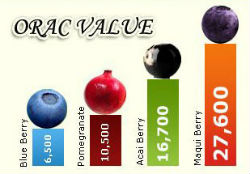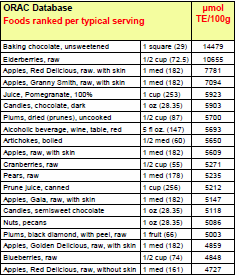What does an ORAC score really mean?
ORAC scores are commonly used on food and supplement labels as a way to advertise health benefits, but I’d guess most people don’t know what it really measures. It’s just one of those things people take as a cue as to whether something’s healthy or not.
If you’re using ORAC scores to help you make purchasing decisions you deserve to know what it is, what it isn’t, how it changes, and how it can be manipulated.
ORAC Score: A Measure of a Food’s Antioxidant Capacity
The intent of an ORAC score is to measure how powerful of an antioxidant a food is.
ORAC stands for Oxygen Radical Absorbance Capacity. It’s an assay done in a test tube that measures how much a particular substance (like acai extract or cinnamon) stops free radicals from degenerating fluorescent molecules. It’s units are called TE’s which can range anywhere from 50 to 15,000. The higher the score the more powerful the antioxidant.
What’s good about an ORAC score?
- It’s an easy way to compare the inherent antioxidant capacity of different foods
- It measures antioxidant capacity regardless of how long it takes for the oxidation to take place
- The test is more or less standard and pretty accurate for what it measures
But that raises the question: what exactly does it measure?
It might not be what you think.
How An ORAC Score Might Be Misleading
The huge knock on the ORAC score is that it’s done in a test tube, and sometimes what happens in a test tube has no correlation to what happens in your body. None.
This is likely true for the ORAC test.
Why?
- The free radicals used in an ORAC test don’t occur in the body
- There are about 1,234,845.6 different types of oxidizing reactions that can take place in your body, and an ORAC score measures exactly 1 of them.
- ORAC scores can actually differ for the same food depending on the particular method used.
- ORAC scores can lower by as much as 90% when foods are cooked or processed
- Different antioxidant molecules behave very differently in an ORAC test
- The biological significance of the ORAC test has actually not been determined
- ORAC scores can be easily manipulated.
At best it means ORAC scores can be a general approximation of the antioxidant potential of a food. At worst it means an ORAC score can be completely useless and a tool for manipulation.
Let’s talk about that.
How an ORAC Score Can Be Manipulated
The measuring units of the ORAC score can change with the density of the food. So a grape can actually have a lower antioxidant score than a raisin which comes from the exact same food source.
This means the antioxidizing capabilities of natural foods which are high in water can be underestimated while highly processed foods which have had the water and insides sucked out of them can be overestimated using an ORAC score. The ORAC score also hasn’t been officially validated by federal agencies and companies get in trouble all the time for attaching false health claims to ORAC scores.
It’s also important to understand that the value of antioxidants is dependent on the bulk quantity consumed. So even though turmeric or wolfeberry or whatever might be an extremely powerful antioxidant it still won’t mean much if you only add a teaspoon to your recipes every week. The overall effect is nil.
Which Foods Have the Highest ORAC Scores?
Despite their limitations, ORAC scores are still generally useful. Sort of. And a lot of people like to know which foods have how much of them.
Raw cocoa usually tests as having the highest ORAC score. Especially compared to “everyday” foods. Exotic fruits like Acai, wolfberry, noni, goji, etc are all reported to have very high ORAC values, but the truth is there’s no golden standard for comparing them.
The USDA offers this chart of ORAC scores from their website:
So what are the take home points?
- ORAC scores are not the holy grail of health….or even antioxidant capacity
- Be skeptical of foods that frame their value solely on their ORAC score
- Cooking significantly reduces an ORAC score
- If you do cook food, steaming food reduces ORAC scores the least
- Eat fresh, unprocessed foods and you should be fine



You have part of the story correct in that ORAC can be misused and has been in marketing schemes but hte effects of coooking, can either increase or decrease the antioxidant capacity measured. Read the literature on carotenoids.
If ORAC is measured correctly and data expressed appropriately (unitds defined, per fresh weight or dry weight etc.) and amount dconsumed considered, it is a useful comparison.
LikeLike
Ronald,
Thanks. Can you point me to some good literature to illustrate your point?
LikeLike
cooking tomatoes activates lycopene, while cooking carrots activates beta carotene. etc.
LikeLike
Hello Jonathan – so are you saying that if a person eats the tomato raw will they not get the benefits of the lycopene or just not as much as when cooked. And the carrots raw – beta carotene will we still get the benefit raw?
LikeLike
Cooking destroys beta carotene, however Jonathan was right about the lycopene in tomatoes.
LikeLike
Pretty old post but…
Recently the USDA’s Nutrient Data Laboratory (NDL) removed the USDA ORAC Database for Selected Foods from the NDL website due to mounting evidence that the values indicating antioxidant capacity have no relevance to the effects of specific bioactive compounds, including polyphenols on human health.
http://www.ars.usda.gov/Services/docs.htm?docid=15866
LikeLike
Mitch, thanks!
LikeLike
Thanks for this inf
LikeLike
I’m still learning about and trying to understand how this all works. This article has been very good in clarifying. I hope for more information on this subject in the future. Thank you for posting this.
LikeLike
Im a 90 for Lifer I use Dr Wallachs with Youngevity Products They can cure over 900 diseases. Absoribon is everything Madrew Brewer
LikeLike
Thanks for the blog info. You mentioned that “ORAC scores can actually differ for the same food depending on the particular method used.”. Are you saying there are many different testing ORAC methods?
LikeLike
[…] over 20,000, which is very high for this type of product. In my opinion the ORAC score has some shortcomings as a measure of nutritional value and it’s not officially supported by the different regulatory agencies, but nonetheless a […]
LikeLike
[…] up with a system to rate the antioxidant/anti-inflammatory value of foods. There is a lot of debate surrounding this scoring system, however, you can, without question use the ORAC scoring system to find foods […]
LikeLike
What do you know about Wallach’s Youngevity Healthy Chocolate? I am getting emails about ORAC score wise… and read your info…thanks.
LikeLike
Hey Rich,
I’ve never heard of Wallach’s Youngevity chocolate. To be honest, my opinions about the ORAC test have changed a little bit since I’ve written this. I still think my caveats are true, but at the end of the day it’s one of the more useful and definitely one of the most objective tests out there. It’s standardization is the cause for its benefits and drawbacks.
Cocoa in general has a very high antioxidant content regardless.
LikeLike
Great blog about ORAC values. I wish you had references though as I would like to use your info for my book I’m writing… I can reference your blog but some original sources would give it more legitimacy. If you have any please forward to dr.charney@naturopathicmilestones.com
Thanks!
ps. please don’t use my email filled out as I never access it.
LikeLike
Jonathan – Yes.. its complicated !! (ORAC assay scores – in vitro – & one of many oxidation reactions happening in vivo) – May be, some day, the measure will be refined, amplified & calibrated differently – in a more sophisticated way / different methodology, that addresses the weaknesses of the existing regimen. As long as we’re not getting misled… or BS’ed – by Big Biz / Big Corp / Big Agro & all the cartels that seek to manipulate & control / mislead thru misinformation & disinformation. We HOPE the name “BECHTEL” does not signify ANY ominous, sinister connections – that emanate from that hydra-headed octopus – with its tentacles & influence everywhere globally – ie the Bechtel Corporation !!
LikeLike
Ranjit,
Great comment, and no I have no affiliation with the Bechtel corporation.
LikeLike
I’m new to the whole idea of whole food supplements, but, understanding that if I desire a longer life, I need better nutrition. I grew up into my teens eating fresh veggies and other other foods grown at home. As an adult, knowing canning processes, I prepared food for my family in every season. I grew up gardening all spring & summer then canning in the fall. Nutrients, as I knew them while growing up, can never be the same back then. We need supplements that our grand- and great-grand parents got without thinking. That being said, it doesn’t matter how fresh we work towards our food source, we must be aware that our soil is not as enriched as we need it.
LikeLike
I am a Reliv distributor here in the Philippines. The country is flooded with supplements of all sorts, and most of them, if not locally made, pride themselves of ORAC values. I guess that is important to them. So, I wrote my company and asked about Reliv’s ORAC value. Here is their response:
“The Relìv products have not been tested for oxygen radical absorbance capacity (ORAC); therefore we do not have a value to provide. We really don’t feel this is a necessary procedure at this time. Please know there is no industry standard for measuring ORAC values; marketers may overinflate the ORAC value of their supplements. Different growing and harvesting conditions, including the season and temperature, influence the ORAC value of a particular plant by as much as fourfold: ORAC value can be influenced by how the plant material is dealt with, for instance cooking, freezing, and storage. Simple assays including the oxygen radical absorbance capacity and DPPH (2, 2′-diphenyl-l-picrylhydrazyl) were designed to measure an individual antioxidant’s free radical scavenging capacity. Manufacturers sometimes include the results of these tests on labels, implying that because of the presence of antioxidant compounds, foods themselves have higher antioxidant capacity. These antioxidant measurements do not necessarily predict how a food or product will react in the human body, or whether it will maintain antioxidant benefits when ingested.
We are confident that the Reliv products are highly absorbed by the body and provide the superior nutrition that we indicate on the label due to the overwhelming positive feedback we receive from the field. We stand behind the products and also offer a 30 day money back guarantee for our customers.”
With this being said, I am satisfied with their answer. Reliv delivers results. If you want more information about Reliv, please email me at reliv101@aol.com or visit the website www. reliv.com
LikeLike